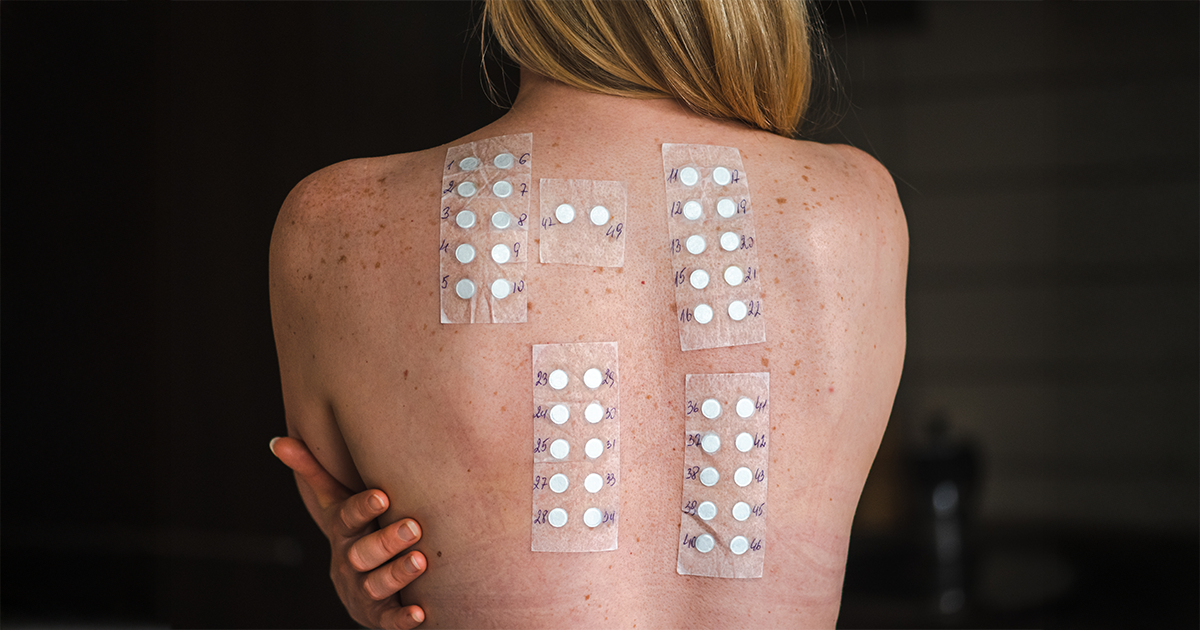
We all know the feeling — a fresh skincare buy in hand and the urge to use it immediately. We totally get the excitement of trying something new! But, hold on. Before applying any new product to your entire face or body, it’s important to perform a patch test for skin. So, if you just do this simple thing before your skincare routine, it can keep you away from unwanted redness, itchiness, or dryness. Those are the allergic reactions that might occur due to some ingredients in the products that your skin may not tolerate.1 2 While a patch test only takes a few minutes, it can save you from a lot of trouble later.
Curious to know how to do a patch test correctly? In this blog, we’ll walk you through each step. But before we dive in, let’s first understand what a patch test really is.
What Is A Skin Patch Test?
In simple words, a patch test helps you find out if the skin reacts negatively to certain ingredients.1 2
When it comes to skincare, a patch test usually means applying a small amount of a product to a discreet area of the skin (like behind the ear or under the elbow). And then observing it for any signs of an allergic reaction over the next 24 hours.3 This is simple and can be done at your own pace.
In a more advanced form, a patch test is done by dermatologists to diagnose conditions like contact dermatitis. In this case, doctors apply medical-grade allergens to the person’s back. They use adhesive patches to identify specific triggers such as metals, fragrances, or dyes.1
Now that you know what a skin patch test is, continue reading to learn about its importance.
Why Is A Skin Patch Test Important?
You may come across many skincare products labelled as “natural” or “dermatologist-tested,” and yes, it may seem tempting to try them right away. But just because something says “natural” doesn’t always mean it’ll suit your skin. Natural ingredients like essential oils and plant extracts can be potent allergens for many.4 5 They may cause dryness, redness, or tiny bumps on the face. Also, if you have extra sensitive skin, the chances of irritation are even higher.6 That is why it is always recommended to do a patch test before applying any new skincare product to the face or body.
That said, doing a patch test can help you:
- Avoid negative skin reactions early which can help keep your skin barrier healthy and safe.3
- Save money on products that don’t work for you (right? lol).
When Should You Do A Patch Test For Skin?
To be honest, the best time to do a patch test is whenever you’re trying a new skincare product. And it's all the more important if the product contains active ingredients like AHAs.
Let’s say your serum has exfoliating acids like AHAs and is popular and effective, no doubt. But studies suggest that higher concentrations of AHAs in skincare products can sometimes cause skin irritation, including redness, stinging, or even mild swelling.7 So be careful before applying it! Because if something has worked for someone else, it doesn’t guarantee it’ll suit you the same way.
The same goes for essential oils, added fragrances, or dyes. They are a common form of allergen in many cosmetics and skincare products that can trigger irritations.8 They might make the product smell or look appealing, but they can quietly irritate your skin without you realising at first. That’s exactly why a quick patch test is worth it — it gives you a heads-up before your skin reacts.
Tips To Perform A Patch Test For Skin At Home
Trying a patch test for the first time? Don’t worry—we’ve got your back (or elbow, in this case)! Here's a simple step-by-step guide to help you do it right before using it on your entire face.:3
1) Pick Your Patch Spot
Apply a small amount of the product on the inside of the arm or elbow. That area is typically pretty close to how your face will respond, so it's a good place for patch testing.
2) Apply It Gently
Use the product the same way you’d use it on your face normally. If it’s a cream or serum, apply a generous amount. If it’s a face wash, apply, wait, and rinse as you would during a normal routine.
3) Wait & Observe
If it’s a rinse-off product, such as a face wash, you can wash it off in about 5–10 minutes. However, if it’s something that stays on, such as a serum, moisturiser, or sunscreen, leave it on for at least 24 hours.
4) Be Patient
Sometimes, skin reactions don’t show up instantly. That’s why you should always repeat the test once or twice for a few days. If you observe any negative reactions, stop using the products.
After doing all this, if your skin continues to react after a patch test, it could be something beyond your skincare. Every day triggers like laundry detergents, perfumes, metals in jewellery, or even certain fabrics can also irritate the skin.
In such cases, it’s a good idea to visit a dermatologist. They can perform a clinical patch test to help you identify the exact cause.
How Does Dermatologist Patch Testing Work

A clinical patch test can help specify the allergens causing the skin irritation. Here’s how a dermatologist performs a patch test:1
- They apply one or more tiny patches with allergens directly on your back.
- Each patch area is marked and numbered using a pen or marker.
- The patches are covered with tape to keep them in place and observed for 48 hours without getting the area wet or sweaty.
- After two days, the patches are removed and checked for any skin reactions.
- A follow-up check is done on day 2 to catch delayed reactions.
- Based on the results, your dermatologist will suggest ingredients or products to avoid.
What To Expect During & After A Patch Test
During the test, avoid applying other products to that area. If any symptoms appear, gently cleanse the area and apply a soothing moisturiser. If the reaction is severe, painful, or doesn’t go away in a couple of days, see a dermatologist.
Wrapping Up!
Patch test for skin may seem like an extra hassle, but doing so can make a difference. Just 24 hours of waiting can prevent you from dealing with surprise redness, itchiness, or skin irritation.
And at AreoVeda, we put your safety first! And that is why all our products are made with utmost care, backed by EWG verification, Ecocert certifications, and are also cellularly proven. They're safe and gentle enough for moms and babies alike. But since every skin is a little different, we always suggest doing a quick skin patch test first. It’s the easiest way to feel fully confident before adding something new to your routine, especially if you’re someone with super sensitive skin!
FAQs
Can I Skip A Patch Test If The Product Is Natural?
No, you should not!. Even natural ingredients like essential oils or plant ingredients can cause irritation or skin allergies.
Is A Dermatologist-Based Patch Test Painful?
No! It is a painless procedure, unless you react to a substance, in which case you might feel mild itching or skin irritation.
Should I Patch Test Every New Skincare Product?
Yes, it’s important to patch test every new skincare product, even if they are labelled natural. They may contain ingredients like fragrance, dyes, or acids, which can sometimes irritate the skin or cause mild reactions.



.png)








